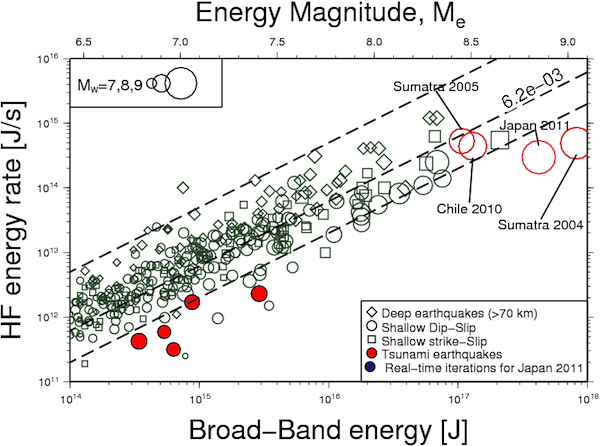2012 IRIS Workshop
The Use of Seismic Energy Release for Real-time Characterization of Tsunami Potential from Slow-source and Giant Earthquakes
Jaime A. Convers: Georgia Institute of Technology, Andrew V. Newman: Georgia Institute of Technology
Relation of the High-Frequency (0.2-2 s) energy release rate to the broadband energy (0.5-70 s) for the events of Mw> 6.7 since the year 2000, scaled according to their gCMT magnitude. As most earthquakes seem to follow a scaling relation of broadband energy with high-frequency energy release rate, tsunami earthquakes, the Sumatra 2004 and Japan 2011 events, deviate from this trend in contrast to other Mw 8.5 and larger earthquakes including the 2010 Chile and the 2005 Sumatra events.

Full-resolution graphics file in original format: 0108.png
While the vast majority of subduction interface earthquakes remain deeper than approximately 20 km depth, a few rare events rupture the more shallow and seismically slow region near the trench. These have the potential for enhanced tsunami excitation. Two such classes are known: 1) Slow “tsunami earthquakes”, which rupture almost in entirety in this region. 2) Some giant earthquakes that rupture from the base of the seismogenic zone through to the trench. We term these events as “total megathrust rupture”. We examine the seismically observable relative energy growth, as this method is easily applied to real-time warning. We examine the radiated seismic energy and the cumulative energy release rate of recent earthquakes (from the year 2000 and Mw>6.7). Amongst the largest earthquakes in our dataset, we examine the results for the Tohoku-Oki 2011 earthquake and other recent large and shallow dip-slip earthquakes, like the Chile 2010, and Sumatra 2004 and 2005 earthquakes. After a comparison of the energy content and high-frequency energy release rate of these events to our a global set of earthquakes, we find that the Tohoku-Oki earthquake is deficient in energy rate relative to other observed megathrust earthquakes, such as the 2004 Sumatran earthquake, and similar to smaller tsunami earthquakes. These contrast other Mw 8.5 and larger earthquakes including the 2010 Chile and the 2005 Sumatra events, which did not create substantial transoceanic tsunamis. The slow energy growth observed in the 2011 Tohoku-Oki and 2004 Sumatran earthquakes, we argue, is due to slowed rupture in the shallow megathrust.
Acknoweldgements: NSF Geophysics-0847382 USGS/NEHRP-08HQGR0028
Keywords: earthquake_energy, megathrust_earthquakes, tsunami_earthquakes, real_time
